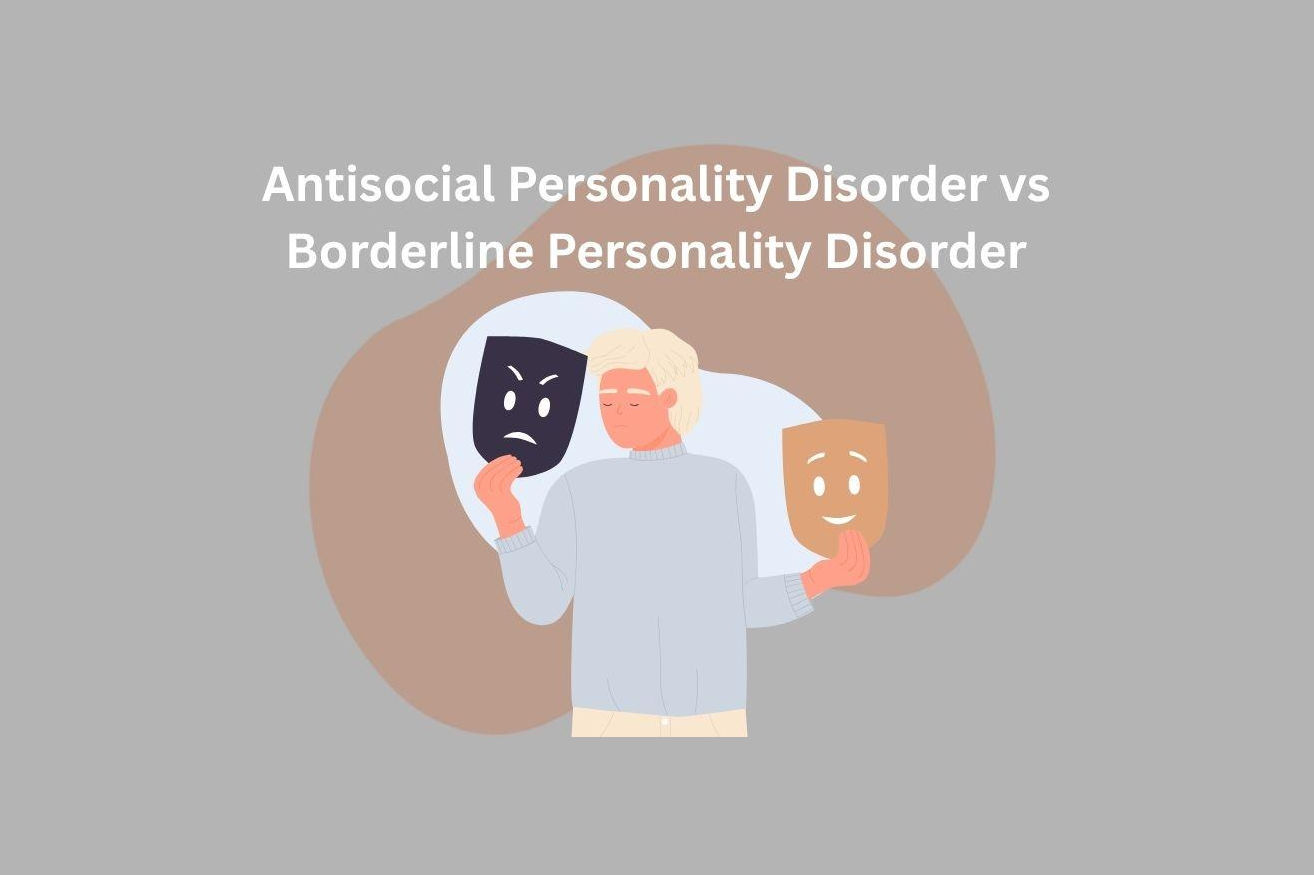
ASPD vs Borderline Personality Disorder: Key Differences Explained

Mental health disorders are often complex and overlapping. Two of the most commonly misunderstood and misrepresented are Antisocial Personality Disorder (ASPD) and Borderline Personality Disorder (BPD). While both belong to the same cluster of personality disorders - Cluster B, which is marked by emotional instability, impulsivity, and difficulty in interpersonal relationships - they are significantly different in terms of causes, symptoms, behavioral patterns, and treatment approaches.
This blog unpacks the nuances of these two personality disorders, not just in clinical terms but through a human-centered lens - because behind every diagnosis is a person trying to be understood.
What is Antisocial Personality Disorder (ASPD)?
ASPD is a personality disorder marked by a persistent disregard for social norms, rules, and the rights of others. People with ASPD often exhibit manipulative, deceitful, and sometimes criminal behavior, and they frequently lack remorse for their actions.
Key Traits of ASPD:
- Disregard for right and wrong
- Persistent lying or deception
- Exploiting others for personal gain
- Impulsivity or failure to plan ahead
- Aggressiveness, often with physical fights
- Lack of empathy and remorse
- Irresponsibility in work or financial obligations
ASPD is more commonly diagnosed in men, and symptoms often begin in childhood or early adolescence, usually as Conduct Disorder, before transitioning into ASPD in adulthood.
What is Borderline Personality Disorder (BPD)?
BPD, on the other hand, is characterized by intense emotional experiences, unstable relationships, and a fragile sense of self. Individuals with BPD often live on an emotional rollercoaster, fearing abandonment, struggling with identity, and battling with intense mood swings.
Key Traits of BPD:
- Intense fear of abandonment (real or imagined)
- Unstable personal relationships
- Rapid mood changes and emotional instability
- Chronic feelings of emptiness
- Impulsive behaviors (e.g., substance abuse, binge eating)
- Self-harming behaviors or suicidal ideation
- Distorted self-image
- Extreme reactions to perceived criticism or rejection
BPD is more frequently diagnosed in women and typically becomes noticeable in late adolescence or early adulthood.
Core Differences: ASPD vs BPD
1. Empathy and Remorse
One of the starkest differences between ASPD and BPD lies in empathy.
2. Intent and Motivation
- ASPD behaviors are often goal-driven - whether for power, control, or personal gain. There is usually a manipulative intent behind their actions, and they may hurt others without guilt if it serves their interest.
- BPD behaviors, however, are often emotion-driven. The actions may seem erratic or destructive, but they usually stem from fear-especially fear of rejection or abandonment. For instance, a person with BPD may lash out at a loved one not to hurt them, but out of panic over feeling unloved.
3. Attachment Style
- ASPD individuals tend to avoid deep emotional bonds. They may see relationships as tools for manipulation and control.
- BPD individuals,, conversely, often crave closeness but fear it at the same time. Their attachment style is typically anxious-preoccupied: intensely attached yet terrified of being abandoned.
4. Aggression and Violence
- People with ASPD may show premeditated aggression and have a higher likelihood of engaging in criminal activities, including violent crime.
- People with BPD are more self-destructive than outwardly violent, though they can exhibit intense anger. Their rage is usually reactive and linked to emotional pain, not a desire to dominate or harm for gain
5. Sense of Self
- ASPD individuals may have an inflated self-image or even a grandiose sense of self-worth, often minimizing or denying their flaws.
- BPD individuals often suffer from a distorted or fragmented self-image. They may feel like they don’t know who they are, shifting between extremes-from feeling unworthy to suddenly feeling special or invincible.
6. Relationships
- ASPD relationships are often exploitative or shallow. There may be a pattern of using others for financial gain, status, or power.
- BPD relationships are often intensely emotional and unstable. People with BPD may idolize someone one moment and devalue them the next. This 'splitting' - seeing people as all good or all bad - is a hallmark of BPD.
Causes and Contributing Factors
ASPD:
- Genetics: Family history of personality disorders or mental illness
- Environment: Childhood abuse, neglect, or exposure to violence
- Neurological factors: Abnormalities in brain regions associated with impulse control and empathy
BPD:
- Genetics: A tendency to run in families
- Environment: Chronic trauma, especially emotional neglect or abuse in early childhood
- Neurological: Differences in brain function related to emotional regulation and stress response.
Diagnosis and Misdiagnosis
Both ASPD and BPD are diagnosed based on criteria in the DSM-5 and require careful psychological evaluation.
However, due to overlapping symptoms like impulsivity, emotional dysregulation, and relationship issues, misdiagnosis can occur. For example, a woman with intense emotional reactions and poor coping skills may be misdiagnosed with BPD, while her behavior might actually be better explained by trauma or complex PTSD.
Likewise, someone with ASPD traits may 'mask' symptoms through charm or manipulation, leading to an underdiagnosis or mistaken identity as a 'normal high-achiever' in social settings.
Treatment Approaches
ASPD:
Treating ASPD is challenging because of the individual's lack of motivation to change. However, therapies like Cognitive Behavioral Therapy (CBT) and anger management can help in some cases, especially when combined with structured environments (e.g., incarceration or mandated programs).
- Medication: May be used to address co-occurring conditions like depression or substance use
- Prognosis: Poor, especially if the person does not see a problem in their behavior
BPD:
BPD is more responsive to treatment than ASPD, particularly with evidence-based therapies like:
- Dialectical Behavior Therapy (DBT): Focuses on mindfulness, distress tolerance, and emotional regulation
- Mentalization-Based Therapy (MBT): Helps clients understand their own and others’ mental states
- Schema Therapy: Targets maladaptive life patterns and core beliefs
- Medication: Used to manage symptoms like mood swings or anxiety but not a primary treatment
- Prognosis: Fair to good, especially with long-term therapy and strong support systems
Living with ASPD or BPD
It's important to remember that people are not their diagnosis. While labels like ASPD and BPD can help clinicians and individuals better understand challenges, they can also lead to stigma.
People with ASPD are not inherently “evil,” and those with BPD are not “crazy.” Many are survivors of deep psychological wounds, and their behaviors—while problematic—often stem from unmet emotional needs, trauma, or neurological differences.
Final Thoughts
Antisocial Personality Disorder and Borderline Personality Disorder share surface-level similarities, such as emotional dysregulation and interpersonal difficulties. But their inner emotional worlds, motivations, and capacity for empathy differ greatly. Understanding these distinctions helps reduce stigma, promote empathy, and enables more tailored treatment approaches. Whether you are a mental health professional, someone who loves a person with one of these disorders, or are navigating a diagnosis yourself, compassion and education are key.
After all, every behavior has a story behind it. And with the right support, healing isn’t just possible - it's powerful.
image credit : freepik

How Psychotherapy Helps in Late-Life Depression And Anxiety: A Path to Healing, Hope, And Healthy Aging
How Social Isolation Impacts Geriatric Mental Health? How to Reverse It?

